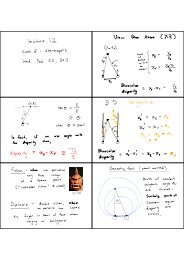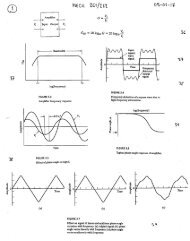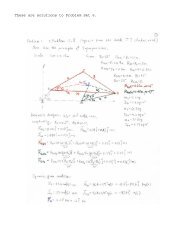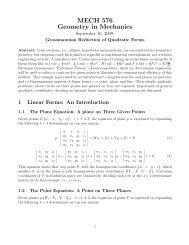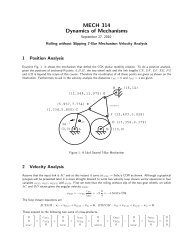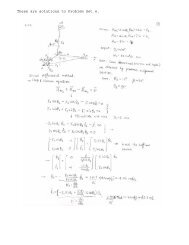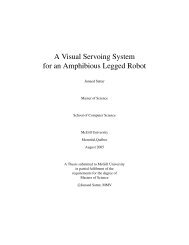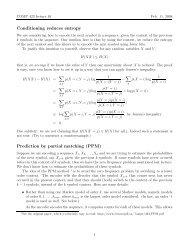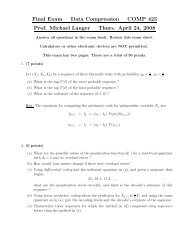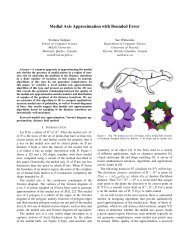- Page 1: Medial Spheres for Shape Representa
- Page 4 and 5: My labmates over the years have mad
- Page 6 and 7: ABRÉGÉ Cette thèse présente une
- Page 8 and 9: DECLARATION This thesis presents or
- Page 10 and 11: I Medial Spheres - Construction 23
- Page 12 and 13: 8 Application to Proximity Queries
- Page 14 and 15: LIST OF FIGURES Figure page 1-1 A
- Page 16 and 17: 2-11 Left: The original polyhedra;
- Page 18 and 19: 6-3 A head model approximated using
- Page 20 and 21: Chapter 1 Introduction This chapter
- Page 22 and 23: Figure 1-1: A ‘bunny’ shape rep
- Page 24 and 25: 1.1.2 Implicit/Interior Representat
- Page 26 and 27: narrow boundary features, as prohib
- Page 28 and 29: and a line segment cannot be a soli
- Page 30 and 31: Figure 1-4: Top: The medial axis (b
- Page 32 and 33: Figure 1-6: Different classes of po
- Page 34 and 35: Voronoi Diagram The Voronoi diagram
- Page 36 and 37: (a) (b) (c) (d) Figure 1-8: (a) A u
- Page 38 and 39: Part II investigates the descriptiv
- Page 40 and 41: can be quickly updated and how the
- Page 42 and 43: Part I Medial Spheres - Constructio
- Page 46 and 47: Figure 2-3: Left: The medial surfac
- Page 48 and 49: Figure 2-4: The edges Voronoi diagr
- Page 50 and 51: the poles). Aichholzer et al. [5, 3
- Page 52 and 53: set of disjoint convex sites, the e
- Page 54 and 55: the medial surface of a polyhedron
- Page 56 and 57: Figure 2-5: Arrows show ∇D, the d
- Page 58 and 59: size. The algorithm we will describ
- Page 60 and 61: 2.4.1 Precise Medial Points Given a
- Page 62 and 63: the theory of geometric curve evolu
- Page 64 and 65: point are P = B(p) and Q ′ = p+d(
- Page 66 and 67: (a, b) that cross B, and further, i
- Page 68 and 69: Algorithm 2 SALIENTMEDIALPOINT(Φ,
- Page 70 and 71: Consider a medial sphere with radiu
- Page 72 and 73: (left) shows 20 spheres whose envel
- Page 74 and 75: Figure 2-10: An example of an objec
- Page 76 and 77: Figure 2-11: Left: The original pol
- Page 78 and 79: object bounding box. The sampling r
- Page 80 and 81: lists these parameters, along with
- Page 82 and 83: Chapter 3 Theoretical Analysis: 3D
- Page 84 and 85: Figure 3-1: When B consists of two
- Page 86 and 87: of the line l with π1. Since ∠Cp
- Page 88 and 89: Figure 3-3: If a medial point m is
- Page 90 and 91: other point in Θ is outside of V (
- Page 92 and 93: When computing the full foam, consi
- Page 94 and 95:
We will show that either the distan
- Page 96 and 97:
of the medial points that are not d
- Page 98 and 99:
Chapter 4 Theoretical Analysis: 2D
- Page 100 and 101:
Let l(a, b) denote the line through
- Page 102 and 103:
Figure 4-2: Cases A (Left) and B (R
- Page 104 and 105:
Algorithm DECIDEMA performs O(N) di
- Page 106 and 107:
Let N be big enough such that L < 2
- Page 108 and 109:
Thus, ∠uwv is not maximum when w
- Page 110 and 111:
Taking the derivative with respect
- Page 112 and 113:
Let X, Y and P be the nearest point
- Page 114 and 115:
In this case, the y-coordinate of Y
- Page 116 and 117:
disks, we ensure that if a medial p
- Page 118 and 119:
Part II Quality of Shape Descriptio
- Page 120 and 121:
5.1 Differential Geometric Shape Op
- Page 122 and 123:
are sampled on a particular kind of
- Page 124 and 125:
Figure 5-1: An illustration of S a
- Page 126 and 127:
medial surface is approximated by a
- Page 128 and 129:
When working with approximate media
- Page 130 and 131:
Let v2 = NMS(x0) × v1 , (5.11) NMS
- Page 132 and 133:
it may happen that all the approxim
- Page 134 and 135:
Proof. Equation 5.7 can be rewritte
- Page 136 and 137:
Figure 5-4: Left: Approximate media
- Page 138 and 139:
Figure 5-6 presents results for ano
- Page 140 and 141:
However, existing discrete differen
- Page 142 and 143:
Chapter 6 A Significance Measure fo
- Page 144 and 145:
of a sheet is also related to the o
- Page 146 and 147:
1 sheet 2 sheets 4 sheets 38 sheets
- Page 148 and 149:
6.4.2 Shape Indexing and Retrieval
- Page 150 and 151:
Chapter 7 Fast and Tight Spheres In
- Page 152 and 153:
We now overview methods that seek a
- Page 154 and 155:
Figure 7-1: A polyhedron (Left) and
- Page 156 and 157:
A be the complement of a set A. The
- Page 158 and 159:
The method of Bradshaw and O’Sull
- Page 160 and 161:
Figure 7-3: Error and timing result
- Page 162 and 163:
Incorrect normal estimates or local
- Page 164 and 165:
vol(Ω) − vol(U) + 2(vol(U) −
- Page 166 and 167:
a poorer estimate to a medial spher
- Page 168 and 169:
Chapter 8 Application to Proximity
- Page 170 and 171:
computational problem from collisio
- Page 172 and 173:
measurement is outside the polyhedr
- Page 174 and 175:
e the side length of the voxels use
- Page 176 and 177:
8.5 Experimental Results We evaluat
- Page 178 and 179:
our method, a small value of σ nee
- Page 180 and 181:
spheres. However, we must note that
- Page 182 and 183:
dual complex of the associated ball
- Page 184 and 185:
Figure 8-4: A fat triangle, or the
- Page 186 and 187:
and the power diagram of balls, we
- Page 188 and 189:
the medial surface. For a finite sa
- Page 190 and 191:
Listing of Future Work Throughout t
- Page 192 and 193:
REFERENCES [1] CGAL, Computational
- Page 194 and 195:
[24] F. Cazals, H. Kanhere, and S.
- Page 196 and 197:
[52] H. Federer. Curvature measures
- Page 198 and 199:
179 [77] G. Lavoué, F. Dupont, and
- Page 200 and 201:
[103] D. Shaked and A.M. Bruckstein



